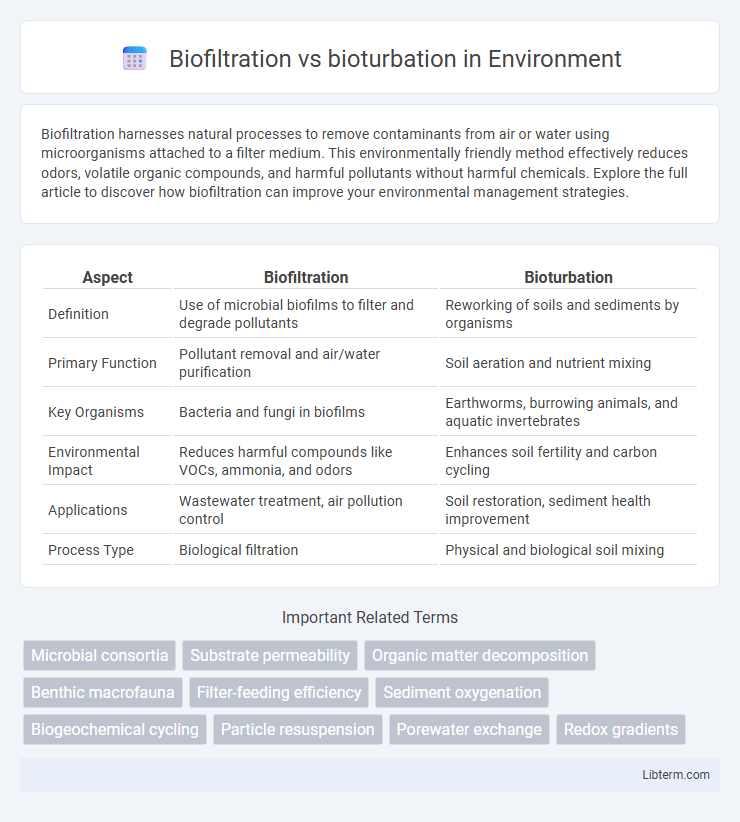Biofiltration harnesses natural processes to remove contaminants from air or water using microorganisms attached to a filter medium. This environmentally friendly method effectively reduces odors, volatile organic compounds, and harmful pollutants without harmful chemicals. Explore the full article to discover how biofiltration can improve your environmental management strategies.
Table of Comparison
| Aspect | Biofiltration | Bioturbation |
|---|---|---|
| Definition | Use of microbial biofilms to filter and degrade pollutants | Reworking of soils and sediments by organisms |
| Primary Function | Pollutant removal and air/water purification | Soil aeration and nutrient mixing |
| Key Organisms | Bacteria and fungi in biofilms | Earthworms, burrowing animals, and aquatic invertebrates |
| Environmental Impact | Reduces harmful compounds like VOCs, ammonia, and odors | Enhances soil fertility and carbon cycling |
| Applications | Wastewater treatment, air pollution control | Soil restoration, sediment health improvement |
| Process Type | Biological filtration | Physical and biological soil mixing |
Introduction to Biofiltration and Bioturbation
Biofiltration is a natural or engineered process that uses living microorganisms to remove contaminants from air, water, or soil by breaking down organic pollutants and converting them into harmless substances. Bioturbation refers to the reworking of soils and sediments by animals or plants, which enhances nutrient cycling and oxygenation, thereby influencing the physical and chemical properties of the environment. Both biofiltration and bioturbation play crucial roles in ecosystem health and pollution mitigation by leveraging biological activity to improve environmental quality.
Defining Biofiltration: Mechanisms and Applications
Biofiltration involves the use of microbial communities to degrade or remove contaminants from air, water, or soil through natural biological processes such as adsorption, biodegradation, and filtration. Mechanisms of biofiltration include microbial metabolism that breaks down pollutants into less harmful substances, often applied in wastewater treatment, air purification, and industrial effluent management. This environmentally sustainable technology enhances pollutant removal efficiency by optimizing parameters like media type, microbial population, and airflow or hydraulic retention time.
Understanding Bioturbation: Processes and Roles
Bioturbation refers to the reworking of soils and sediments by living organisms, primarily driven by burrowing animals, worms, and microbes, which significantly influences soil structure, aeration, and nutrient cycling. This process enhances organic matter decomposition, promotes microbial activity, and improves sediment permeability, playing a critical role in ecosystem functioning and sediment stability. Unlike biofiltration, which mainly involves biological filtering of contaminants through plants and microorganisms, bioturbation directly modifies the physical properties of sediment and soil environments.
Key Differences Between Biofiltration and Bioturbation
Biofiltration involves the use of microorganisms in a medium like soil or water to remove contaminants, enhancing water and air quality through biological processes. Bioturbation refers to the disturbance and reworking of sediment or soil by organisms such as worms and burrowing animals, affecting sediment structure and nutrient cycling. Key differences include biofiltration's focus on pollutant removal and purification versus bioturbation's role in physical sediment alteration and ecosystem engineering.
Microbial Communities in Biofiltration vs Bioturbation
Microbial communities in biofiltration consist primarily of specialized bacteria and fungi that degrade organic pollutants through metabolic processes, enhancing water and air purification. In contrast, bioturbation influences microbial diversity by physical sediment mixing and oxygenation, promoting heterogeneity and stimulating microbial activity in aquatic and soil ecosystems. These differing microbial dynamics underline biofiltration's efficiency in contaminant removal versus bioturbation's role in ecosystem health and nutrient cycling.
Environmental Benefits of Biofiltration
Biofiltration enhances environmental quality by removing pollutants such as nitrogen, phosphorus, and organic compounds from air, water, and soil through microbial activity. This natural process supports biodiversity and improves ecosystem health by reducing harmful substances and restoring nutrient cycles. Unlike bioturbation, which primarily influences sediment structure and aeration, biofiltration directly mitigates contamination and contributes to sustainable water and air management systems.
Ecological Impacts of Bioturbation
Bioturbation significantly alters sediment structure and nutrient cycling by reworking soil and sediment layers, which enhances oxygen penetration and microbial activity, promoting overall ecosystem productivity. This process influences sediment biogeochemistry by redistributing organic matter and minerals, impacting the habitats of benthic organisms and affecting water quality. Compared to biofiltration, which primarily improves water quality through microbial degradation in filters, bioturbation drives physical and chemical changes in aquatic and terrestrial environments that sustain biodiversity and ecosystem resilience.
Comparative Effectiveness in Pollution Reduction
Biofiltration effectively reduces pollutants by leveraging microbial communities to degrade contaminants in air and water, achieving high removal rates of volatile organic compounds and nitrogen compounds. Bioturbation enhances sediment oxygenation and organic matter degradation through the activities of benthic organisms, indirectly promoting pollutant breakdown in aquatic ecosystems. Studies show biofiltration provides more consistent and rapid pollutant reduction in controlled environments, while bioturbation contributes to long-term sediment detoxification and nutrient cycling in natural habitats.
Real-world Case Studies: Biofiltration and Bioturbation
Real-world case studies demonstrate biofiltration's effectiveness in wastewater treatment plants where microbial biofilms degrade organic pollutants, enhancing water quality and reducing environmental impact. Coastal ecosystems illustrate bioturbation's role through benthic organisms like worms and crabs that aerate sediments, promoting nutrient cycling and supporting diverse marine life. Comparative analyses reveal biofiltration excels in engineered systems for contaminant removal, while bioturbation drives natural sediment dynamics essential for ecosystem health.
Future Perspectives and Integrated Approaches
Future perspectives in biofiltration and bioturbation emphasize the integration of microbial and macrofaunal processes to enhance ecosystem remediation and resilience. Combining biofiltration's microbial nutrient cycling capabilities with bioturbation's sediment mixing effects can optimize pollutant degradation and habitat restoration. Advanced modeling and biotechnological innovations aim to harness these synergistic interactions for sustainable environmental management.
Biofiltration Infographic

 libterm.com
libterm.com